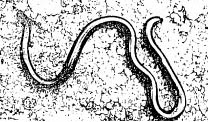Of some 35 species of "macro" moths recorded as new to Hong Kong during the first six months of Ph.D. fieldwork, 3 represent two subfamilies not previously recorded in the territory. These are: New Moth Records
Thyatira batis (Linnaeus, 1758), Thyatirinae (Drepanidae), collected KARC 23 March 1997;
Sugitania lepida Sugi, Cuculliinae (Noctuidae), collected KARC 1 January 1997;
Rhynchaglaea scitula Butler, Cuculliinae (Noctuidae), collected KARC 11 January 1997.
Thyatira batis is a palaearctic species, familiar to naturalists in the UK, where it is known as the Peach Blossom.
ROGER KENDRICK
As reported in Porcupine! 15 (p.31), I photographed an unusual skipper (identified as Parasovia perbella by Dr. A.L. Devyatkin) in Chebaling (northern Guangdong) during a survey of that reserve in June 1996. Dr. Devyatkin has recently reported (Devyatkin, 1996) that this species was previously known from only 2 specimens: one taken in 1911 at Tsha-jiu-san in South China, and another taken at Tamdao in North Vietnam in 1994. Chebaling skipper update
GEORGE WALTHEW
Devyatkin, A.L., 1996. New Hesperiidae from North Vietnam, with the description of a new genus. Atalanta 27: 595-604.
The following have been recorded in Hong Kong but are not marked as such in Mike Bascombe's 1995 checklist (Mem. H.K Nat Hist Soc. 20: 1-206): Two more butterflies for Hong Kong
Pieris naganum (Moore) Naga White, coll. Shingo Murakami, H.K. Island, July 1986;
Lethe verma (Kollar) Straight-banded Tree Brown, coll. Seiji Ogata, Tai Mo Shan, April 1995.
With so many dragonfly species added to the Hong Kong fauna in recent years it is increasingly difficult to find new species. However, a new addition was found by Michael Lau and Graham Reels at Lai Chi Wo on 27 May 1997. Several specimens of the libellulid species Macrodiplax cora (Brauer, 1867) were encountered close to the beach. Full description in next issue. - K.W. ... and another new dragonfly
A Bumblebee for Hong Kong
A bumblebee, identified by Paul Williams of the British Natural History Museum as Bombus eximius Smith, has been found by Ng Sai Chit on the Hunchbacks (Ma On Shan), at Bride's Pool and on Tiu Tang Lung (Plover Cove Country Park), and by Richard Corlett at Tai Po Kau. All observations were apparently of workers. The bees are 1-1.5 cm long (between Apis cerana and Xylocopa spp.), and black hairy all over except for the brownish wings, more or less shiny top front end of the abdomen, and orange-brown hairy legs and tip of abdomen. This species is widespread in South China and would be expected here. The apparent absence of earlier observations is surprising, considering that all north-temperate naturalists would immediately recognize it. Please report any observations of this species - dates, times, locations, flowers visited etc. - to Richard Corlett at HKU corlett@hkucc.hku.hk. RICHARD CORLETT
At 9.15 on the evening of 5 June Mr. Sarbarjit Gurung, the security officer at Kadoorie Farm, encountered an unusual looking snake at around 500m within the Farm's premises. Mr. Gurung duly photographed the snake and continued his patrol. New Snake at Kadoorie Farm
Subsequent examination of the photograph has revealed that the snake is a species of Boiga (a cat snake). It differs from the known Hong Kong species (B. multomaculata) in size and colour pattern. Pending collection of a specimen, the snake has been tentatively identified as B. kraepelini (recorded from north Vietnam to southern and central China). This brings to 51 the number of snake species recorded from Hong Kong.
JAMES LAZELL & MICHAEL LAU
The wonders of Shek Kwu Chau seem to never cease. On 2 July 1997 Jonathan Kolby, a student assistant working on the Conservation Agency's annual faunal survey, flushed a half dozen small Hemiphyllodactylus geckos from under buckled bark flanking massive scar areas on the trunks of Acacia confusa. Three adult geckos, two males and a female, were apprehended. Several masses of eggs were left undisturbed. A slab of wood was affixed over the largest scar area to help restore the habitat. Shek Kwu Chau Strikes Again!
These geckos seem not to be the same as the Hemiphyllodactylus known from Po Toi and the Aberdeen area of Hong Kong (Lau, M., 1992. Porcupine! 2: 1; Porcupine! 15:33). This genus is very poorly known and its systematics are confused, so it may be some time before it is clear if Hong Kong's species are introduced, or natives new for the region, or species new to science.
JAMES LAZELL & MICHAEL LAU
Civet scats are conspicuous on Kat O Chau (Crooked Island) owing to the animals' habit of defecating in open spaces such as helicopter pads and grave aprons. Even after days of rain, we found civet scats frequently on 19 June 1997, during a biodiversity survey. All scats contained fruit and some contained mats of feathers. One scat on top of a large concrete water tank, built into the hillside at Ko Tei Tung (ca. 60 m) contained a 164 mm Blind Snake, Typhlops ("Ramphotyphlops") braminus . Although partially crushed, the snake shows little external damage and makes a fine voucher specimen (Museum of Comparative Zoology field tag A-15390). Blind Snake Eaten, but not Assimilated, by Civet

The toughness of blind snakes' hide is renowned worldwide. In the West Indies it is said they cannot be chopped in pieces with a cutlass, and here their name is "iron wire snake", ti sin she. The civet species remains unknown.
JAMES LAZELL & MICHAEL LAU

Back to top
Back to Contents
Back to Porcupine Homepage
Go to Departmental Homepage